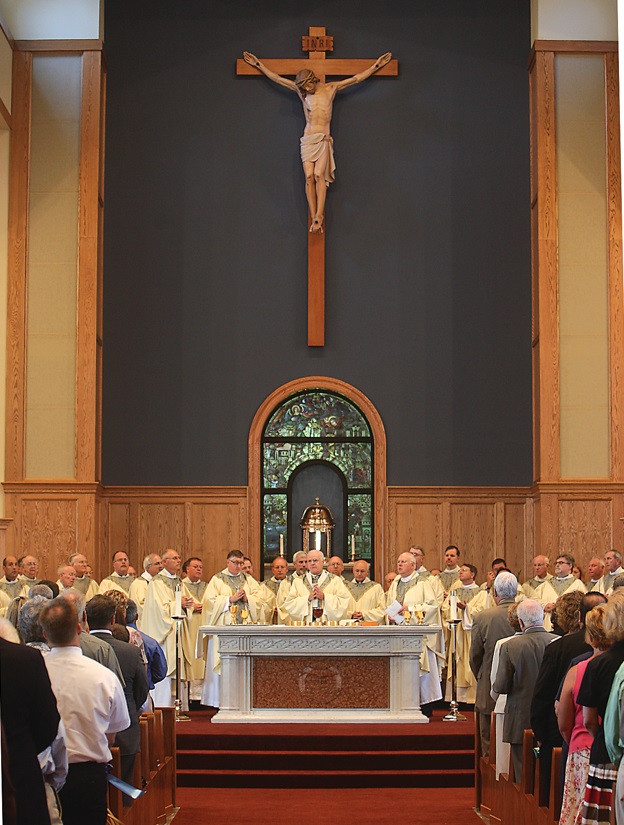LIBERTYTOWN – When Monsignor John Dietzenbach pushed open the doors of the new St. Peter the Apostle Church in Libertytown during a Sept. 7 dedication liturgy, more than 900 parishioners looked on in stunned silence.
Standing on a sun-splashed parking lot behind festive flags, the crowd seemed awed that after four years of sacrifice, fundraising and planning, their new church was finally a reality. Their former church, erected in 1871, was devastated by a 2004 fire when roofers accidentally set the historic steeple ablaze during a renovation project.

“Woo-hoo!” shouted an excited parishioner, breaking the hush a few seconds after Monsignor Dietzenbach opened the doors. With that, other cheers flowed freely and warm applause showered their smiling pastor as he helped lead a procession inside the impressive brick structure while a choir sang “Exultate Justi.”
Moments earlier, Archbishop Edwin F. O’Brien accepted the architectural plans, construction documents and keys to the new church. The archbishop was joined at the dedication Mass by Cardinal William H. Keeler, Archbishop William D. Borders, Bishop Mitchell T. Rozanski, Bishop William C. Newman and more than 40 priests and deacons.
“Four years ago, we gathered around our church with tears of sadness,” Father Dietzenbach said in an interview with The Catholic Review. “Today, we gather with tears of joy.”
The new church features a design by Rubeling and Associates that honors the history of the parish while expanding the size of the worship space to meet the needs of a growing faith community of 1,800 registered families. The destroyed steeple was restored and the building includes a second, shorter steeple inspired by the parish’s original stone church built in 1821 and torn down in 1907.
The brick façade of the burned church was preserved and now houses a daily Mass chapel. The Stations of the Cross were also preserved and given a place of honor in the new church. Nancy Pollack, a professional artist and a St. Peter parishioner, restored a much-loved oil painting of the Crucifixion that previously hung behind the altar of the burned church. The artwork now adorns the daily Mass chapel.
Pieces of stained glass that had been salvaged in the fire were incorporated into a Eucharistic adoration chapel, and a statue of St. Peter that previously marked the location of the original church now stands between the two steeples on an outdoor stone patio.
During the dedication liturgy, Archbishop O’Brien anointed the altar, into which he deposited relics of St. Francis Xavier. Several other priests anointed the church’s walls.
At the start of the Mass, the archbishop said St. Peter was the first new church he has dedicated. Calling their church a “splendid house built to give glory to God,” Archbishop O’Brien said the rebuilding initiative stands as a “historic effort of epic proportions.” He commended parishioners for their dedication to their faith community, to the Eucharist and for their promotion of vocations to the religious life.
In a prayer of dedication, Archbishop O’Brien asked God to send the Holy Spirit to “make this church an ever-holy place, and this altar a ready table for the sacrifice of Christ.”
“Here may prayer, the church’s banquet, resound through heaven and earth as a plea for the world’s salvation,” he said.
Deacon Michael Misulia proclaimed the first Gospel reading in the new church. A retired surveyor, Deacon Misulia played a key role in making the new church a reality after plans for a larger church were almost derailed by rising land costs. After the fire, Deacon Misulia discovered that an expanded church could fit on the original site if it were set on a diagonal plane.
While a lone bagpiper played a joyful air as people gathered at the start of the ceremony, Ginny Abel told The Catholic Review the day was “like a homecoming.”
“We’ve been like a family that was displaced,” said Ms. Abel, a member of the pastoral council. “We’ve been meeting in the parish hall and now here’s our opportunity to all come home. Everyone worked so hard and laid down their lives to make this day possible.”
Constructed by Oak Contracting Company, the new church seats nearly 800 – more than twice the capacity of the destroyed church. The project cost $11.5 million. A capital campaign raised $4 million and the church received $3.6 million in fire insurance money, according to Monsignor Dietzenbach. Additional money has been raised through gifts and fundraising, he said, and a second capital campaign will be launched in October.
“The people have been tremendously supportive,” said Monsignor Dietzenbach. “This is a glorious day for our parish.”
Email George Matysek at gmatysek@CatholicReview.org
Copyright © 2008 Catholic Review Media
